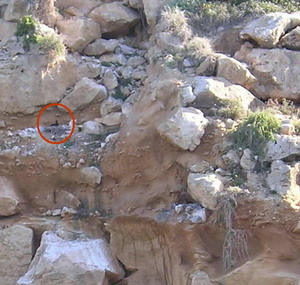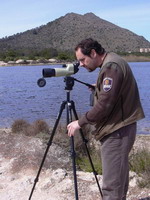Partner: Direcció general de Biodiversitat
Aims:
To monitor colonies inhabiting areas included in the project , and most
specially those birds using places which are most easily accessible to
uncontrolled visits by humans, dogs and other disturbing elements.
Methods and techniques:
These campaigns covered the most important colonies of Audouin
Seagulls—in terms of number of birds—( which generally build
nests in the areas accessible to humans, even if these birds sometimes
change their nesting location from year to year). Also, a variable number
of Common Shag Cormorant colonies were covered, and the exact number of
Cormorant colonies monitored depended on the time and resources spent
monitoring colonies of Audouin Seagulls.
In no case less than five. The control of the colonies was complemented
by adequate sign posting. The goal was to prevent humans from bothering
the birds as this is one of the endangering activities described in the
Community Action Plans. For this action a Service Contract was drawn up
to hire the services of Tragsa and the action was carried out with the
collaboration of specialist experts from the Servicio de Protección
de Especies ( Service for the Protection of Species), and engaging the
help of bird-watching groups and conservationist NGOs able to mobilize
volunteers which were given the adequate means (optical and security equipment,
transport, etc.).
The action was carried out between the months of December 2003 and June
2004 and also between December 2004 and June 2005.
In December the communities of Common Shag Cormorant that were to be monitored
were identified and it was decided where sign posts would be placed. In
April the same was done for the communities of Audoin Seagulls. The work
was carried out in the ensuing months.
Development:
Monitoring was done both by land and sea (using pneumatic “zodiak”
type boats).
Digital photographs were taken of the colonies and further land and sea
trips taken, with repeated visits to colonies that had already been studied
and new visits to colonies that had not previously been studied.
Visits were repeated each year in order to better follow how things were
going in each colony and to check data so that contrasting these would
result in the most useful information.
In the following months, the breeding ones, the work of ringing the legs
of chicks with identification rings continued. This task had been begun
the first year.
This ringing is done with numbered metal and PVC rings and allows the
identification of the individual at a distance using binoculars.
Existing colonies were checked and new nests identified. At the same time
a photographic inventory was made in order to be able to photographically
identify the individuals.
The surveillance and tracking of the Majorcan colonies was carried out
in the following areas:
• Coast of Cap Enderrocat and Cap Regana
• Sa Dragonera Island
• Coast of Tramuntana, between the Port of Sóller and Cap de Formentor
• Coast of the Artà mountain
• South-west coast of Majorca
• Formentor Island and Victoria Peninsula
L. audouinii
During 2005 the census of Audouin Seagull was counted again in the Balearic
Islands and in the other colonies of Spain where most of the world’s
reproducing population of this species, endemic in the Mediterranean,
lives. The collected data is as follows:
Majorca: 76 couples on the island of Moltona (Ses Salines) at 3 locations, 15 couples on the island of Pelada (Ses Salines), 150 couples at Cap Enderrocat (Llucmajor), 15 couples on the island of Sa Dragonera (Andratx) who deserted, and 28 couples at Cap des Freus (Capdepera).
Minorca: 113 couples at two locations of 75 and 38 on the island of Aire (San Luís), an estimated 80 couples on the islands of Porros (Es Mercadal), and an estimated 18 couples at Punta Perpinyá (Ciutadella). Source: Minorcan Ornithology Society-Raül Escandell.
Ibiza: 46 couples at Escull d’en Terra (Ibiza), 108 couples on the island of Santa Eulaia (Santa Eulalia), 264 couples on the island of Espartar, 94 couples on the island of Cala Salada (San Antonio) and an estimated 35 reproducing couples on the island of Calders (Sant Joan).
Formentera , 231 couples on the island of Espardell (San Francisco Javier).
Cabrera: 197 couples at one location on Cala Estreta, Conejera (Source: National Park of Cabrera).
Negative census at:
Mallorca: islets off Colonia Sant Jordi (Ses Salines, coast of Llucmajor,
islets in the Bay of Palma (Palma and Calviá), coast of Rafaubeitg,
island of el Toro and Malgrat islands (Calviá). It was not possible
to carry out a census on the island of Formentor.
Minorca: Cap de Cavalleria (Es Mercadal)
Ibiza: island of Tagomago (Santa Eulalia), islets of Freus (Ibiza and San Franciso Javier), the other western islets (San Antonio).
Formentera: la Mola and Cap Berbería.
Cabrera: the other islets of the archipelago.
It can be said that the designated areas were well covered. The total results are:
Majorca -----> 284 couples
Minorca-----> 211 couples
Ibiza ------> 546 couples
Formentera --> 231 couples
Cabrera ------> 197 couples
Total ----------> 1,469 couples
These facts indicate there has been a slight recovery
with respect to the census of 1,195
couples counted in 2004, and the number is almost the same as the census
of 2003 in which 1,389 couples were counted. The maximum population of
the Balearics was that of 1,956 reproducing couples counted in 2001. This
census was carried out by many people, most connected to the local Ministry
of the Environment ( Consellería de Medi Ambient) and pertaining
to several departments such as the General Directorates of Biodiversity,
Hunting, Protection of Species, and Environmental Education, plus persons
pertaining to Ibanat, and volunteers.
Conclusions:
During the three-year period spanning 2003-2005, the work of monitoring
and locating colonies of Audouin Seagulls continued, as well as the work
of elaborating a census of nesting couples, ringing chicks, reading the
rings and keeping an eye on the breeding spots. The Balearic population
of Audouiin Seagull reached its maximum peak in 2001, when 1,956 reproducing
couples were counted. From that year on the population decreased slowly
until 2005 when there was a slight recovery in number. In 2003, 1,389
couples had chicks, in 2004 the number of reproducing couples descended
to 1,195 and in 2005 the number increased slightly to 1,469 reproducing
couples. The number of spots occupied for breeding purposes has not varied
much during this period, although variations in the location of colonies
has continued as there were 13 in 2003, 16 in 2004, and 15 in 2005. With
respect to the Spanish population, which is the most important in the
world, the Balearic population constitutes 5.77 % (in 1997) and 10.93
% (in 2001) of the total.
P. aristotelis
In order to monitor this species and track the colonies of Majorca, visits
by land and sea (pneumatic “zodiak” type boats) were carried
out.
Results:
In total there were 33 visits of which 9 were by sea and 24 by land. The
following were located:
339 nests
27 probable nests
92 sure nests
49 empty nests
167 nests with an adult sitting on the eggs
19 nests with chicks
During the nest counting the following were observed: 310 individuals of which 234 were adults, 55 were of around one year of age, and 21 were immature.
Digital photographs were taken and GPS data compiled
of the colonies and of dispersed nests.
Chicks were ringed as follows: 26 in 2004 and 29 in 2005 in three colonies
of Majorca and Cabrera. 34 in 2005 in 4 colonies of Ibiza and Formentera.
27 in 2003, 18 in 2004 and 15 in 2005 in 7 colonies of Minorca.
It has been established that human presence occurring during the observation periods did not greatly disturb the birds, except in two cases: one in Vallgornera (Llucmajor) where a fisherman and his equipment were found very near three nests, and the other in Bahía Azul (Llucmajor) where there was an adult bird sitting on the eggs and just four metres below there were three people fishing with rods from the rocks.
Conclusions:
It seems the population has suffered a decrease in comparison with the
last census of 2004. The reasons could be very varied, such as: long-line
fishing, nets, boat traffic, regeneration of beaches, an increase in the
population of common seagulls, etc. Nevertheless, naturally occurring
fluctuations cannot be ruled out.
It can be said that the aims of this action have been fulfilled as data
is now available on the population of both these species and this type
of work will continue to be regularly carried out in order to monitor
how both populations evolve.
Detail of the monitoring work

Photo 1

Photo 2